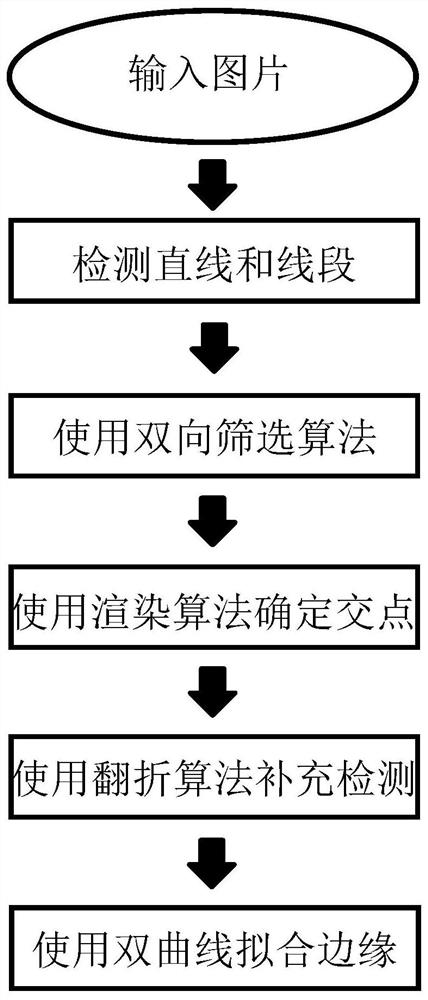Chrysanthemum pool pattern geometrical information extraction method based on detection straight lines and line segments
A technology for geometric information and straight line detection, applied in character and pattern recognition, image data processing, instruments, etc., to achieve fast detection speed, effective and feasible coordinate positioning and detection methods, and high accuracy of detection results
- Summary
- Abstract
- Description
- Claims
- Application Information
AI Technical Summary
Problems solved by technology
Method used
Image
Examples
Embodiment 1
[0050] In this embodiment, a method for extracting geometric information of Kikuchi patterns based on detecting straight lines and line segments includes the following steps:
[0051] a. Detect straight lines and line segments on the material image, including image denoising and edge extraction; when performing edge extraction, first use the Canny operator to extract the edge, and then use the Radon transform and the cumulative probability Hough transform method to extract the edge image Lines and segments;
[0052] b. Use a two-way screening algorithm to screen and match all the detection results to obtain multiple sets of sets with the same direction and similar distances. Each set contains a matching set of a straight line and multiple line segments, and use the filtered straight line to generate the center Line and screen again to get the screened center line;
[0053] c. Use the generated and screened center line to obtain the maximum value range using the rendering algo...
Embodiment 2
[0059] This embodiment is basically the same as Embodiment 1, especially in that:
[0060] In this embodiment, the detected straight line and line segment are respectively the performance of the overall feature and the local feature in the picture of the Kikuchi pattern, so the combination of the two can realize the acquisition of a complete feature. In the step b, the detected straight line and line segment are used as the overall feature and local feature in the Kikuchi pattern picture respectively; Between distances, when the straight line is set to match a line segment, a bidirectional screening algorithm is used to obtain a set of matching sets containing a center line and multiple line segments; the bidirectional screening algorithm adopts the following two assumptions:
[0061] First, if a line segment does not have any straight line to match it, then it has a high probability of being a false line segment;
[0062] Second, if a straight line does not have any line seg...
Embodiment 3
[0071] This embodiment is basically the same as the previous embodiment, and the special features are:
[0072] In this embodiment, since the intersection point of the Kikuchi belt can be approximately considered to be on the centerline of multiple Kikuchi belts, it can be considered that the closer the distance is to the centerline, the more likely the intersection point will be found. Based on this principle, in the step c, the steps of using the rendering algorithm to generate the rendering image according to the center line and obtaining the intersection point of the Kikuchi belt are as follows:
[0073] Assume that since the intersection point of the Kikuchi belt is on the center line of multiple Kikuchi belts, the closer to the center line, the more likely to find the intersection point; design the following rendering algorithm based on the distance to the center line, where d refers to the rendering coordinates to each The distance from the centerline, v is the renderin...
PUM
 Login to View More
Login to View More Abstract
Description
Claims
Application Information
 Login to View More
Login to View More - R&D
- Intellectual Property
- Life Sciences
- Materials
- Tech Scout
- Unparalleled Data Quality
- Higher Quality Content
- 60% Fewer Hallucinations
Browse by: Latest US Patents, China's latest patents, Technical Efficacy Thesaurus, Application Domain, Technology Topic, Popular Technical Reports.
© 2025 PatSnap. All rights reserved.Legal|Privacy policy|Modern Slavery Act Transparency Statement|Sitemap|About US| Contact US: help@patsnap.com



